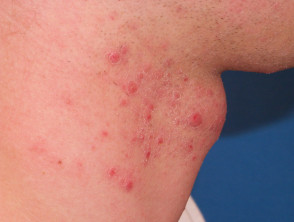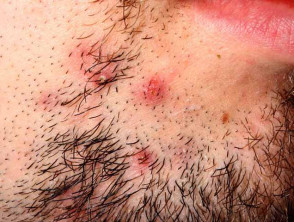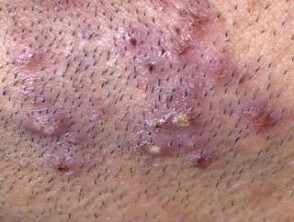What is folliculitis barbae?
Folliculitis barbae is an itchy and sometimes tender papulopustular eruption of hair follicles in skin areas prone to shaving, such as the beard-line in men. It also occurs in women who shave their legs and bikini area.
Deep-seated folliculitis barbae is called sycosis barbae and leads to scarring and areas of permanent hair loss.
Folliculitis barbae presents similarly to pseudofolliculitis barbae (PFB), which is a papulopustular foreign body reaction towards curved hair-follicles that penetrate the perifollicular epidermis as they grow out of the skin (ingrown hairs). PFB presents more frequently in post-shaven hair-bearing areas of persons with more curly and coarse hair, as seen in African Americans.
Both conditions may coexist.
Folliculitis barbae
Who gets folliculitis barbae?
Folliculitis barbae most commonly affects recently shaved hair-bearing areas in men (such as the beard-line) of lighter skin types. Folliculitis may also develop after laser hair removal. However, it may also present in individuals who do not shave.
Cases of folliculitis barbae may occur secondary to viral, mycologic, or eosinophilic causes, and may be seen in competitive athletes and immunosuppressed persons.
What causes folliculitis barbae?
Folliculitis barbae is most often due to Staphylococcus aureus (S. aureus) colonization of more superficial portions of the hair follicle (for example, the infundibulum) and skin surface. However, cases of herpes simplex and candida folliculitis barbae (folliculitis barbae candidomycetica) have been reported.
Reinfection by S. aureus after successful treatment may suggest persistent colonization of S. aureus within the nasal cavity or on previously used shaving equipment, such as razors.
What are the clinical features of folliculitis barbae?
- Itchy, tender, papulopustular eruption surrounding hair follicles in hair-bearing skin areas (such as the beard-line, neck, axilla, and groin)
- Frequently arises after shaving
- Lesions may discharge pus or serous fluid
If the colonization of S. aureus seeds deeper in the skin, it may induce sycosis barbae, which presents as persistent sinus tracts, abscesses, and inflammation deep between hair follicles.
How do clinical features vary in differing types of skin?
Curlier and coarser hairs of persons with darker skin types (such as African Americans) are more likely to penetrate perifollicular epidermis, causing PFB.
While PFB and folliculitis barbae may co-present in darker skin individuals, finer and straighter hairs in persons with lighter skin types are less likely to cause PFB.
What are the complications of folliculitis barbae?
- Postinflammatory hyperpigmentation
- Scarring, hypertrophic scarring, and keloid formation
- Possible hair loss
- Sycosis barbae
How is folliculitis barbae diagnosed?
Folliculitis barbae is often a clinical diagnosis and may be aided by dermoscopy.
In cases of refractory folliculitis barbae, pustule and nasal cavity swabs may be necessary to determine bacterial culture/drug resistance and/or other potential aetiologies.
What is the differential diagnosis for folliculitis barbae?
- Pseudofolliculitis barbae (PFB)
- Tinea barbae
- Eosinophilic pustular folliculitis
- Folliculotropic mycosis fungoides
What is the treatment for folliculitis barbae?
Uncomplicated folliculitis barbae due to S. aureus should respond within 1–2 weeks of treatment with topical antibacterials.
General measures
- Encourage use of disposable razors or cleaning electric shavers with alcohol based antiseptic solution regularly to prevent S. aureus colonization of the grooming tool.
Specific measures
- Limited folliculitis barbae may be managed with topical antistaphylococcal antibiotics, such as clindamycin, mupirocin, and fusidic acid.
- More wide-spread or refractory folliculitis barbae may require oral antistaphylococcal antibiotics, such as flucloxacillin or doxycycline
- Nasal staphylococcal carriage may be eradicated by chlorhexidine/neomycin cream or mupirocin in recurrent or recalcitrant disease.
- Viral and fungal aetiologies may require appropriate antiviral (such as valaciclovir) and antifungal (such as fluconazole) therapies.
- Topical hydrocortisone cream may be used to help reduce inflammation and itching.
- Photodynamic therapy has limited supporting evidence.
What is the outcome for folliculitis barbae?
Cases of folliculitis barbae treated swiftly should resolve without any complications. Refractory, untreated, or persistent cases may lead to the development of sycosis barbae and/or permanent scarring, which may improve in appearance over time.


